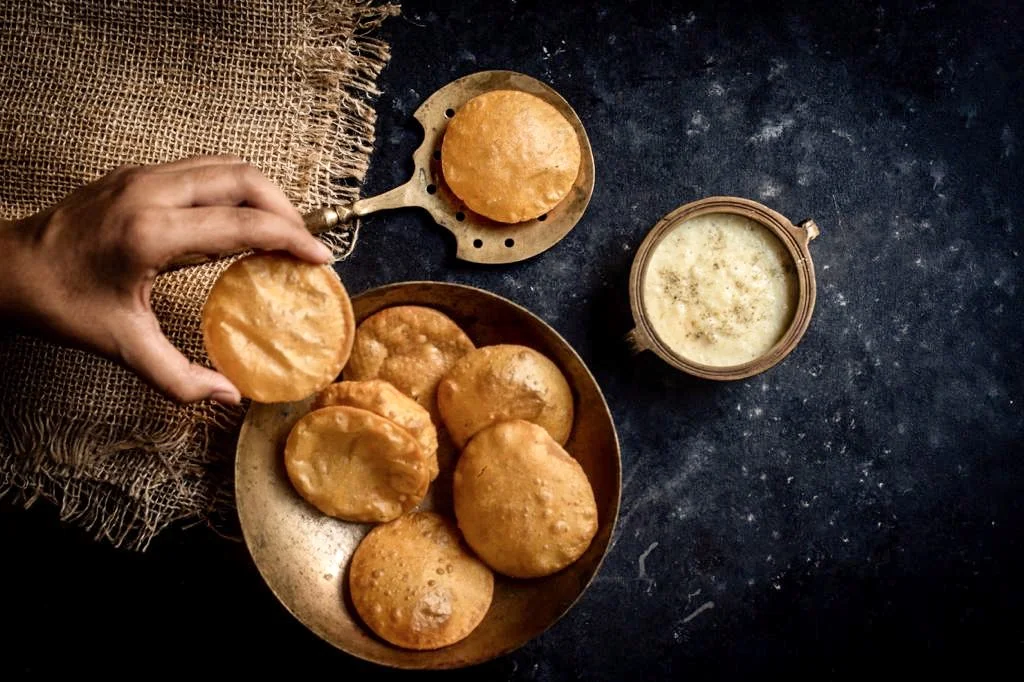Begin Winter Mornings with a Traditional Kheer-Poori

In collaboration with re:store
This delicious pairing of hot pooris, fresh off the stove, and cool, luscious sitaphal kheer, is the perfect way to begin winter mornings with a distinct sense of celebration.
The Gujarati weakness for sweetness runs as deeps as our love for fried food. The perfect combination of these two cravings is the kheer poori, which simply put, is poori eaten with kheer, a milk-based Indian pudding.
When I was growing up, cakes were not yet popular in Chennai, and kheer poori was often a birthday treat that my mother made for us. I deeply loved the contrast of tastes and temperature: the saltiness and heat of poori alongside the chilled, sweet kheer. My mother taught me that the frying of pooris is an art, and that size does matter – in this case, the smaller, the more delicate and dainty, the better.
And sitaphal kheer marries the gorgeous seasonal flavours of the custard apple with the decadent richness of reduced milk. Together, kheer and poori are an unbeatable combination; a luscious dessert, perfect for summers (when it has a cooling effect) and magical when included in year-end festivities when the fruit it in season.
Nandi's Recipe for Poori
Makes 15-20 small pooris
Ingredients
1 cup whole wheat flour
¼ teaspoon turmeric powder
½ teaspoon cumin powder
½ teaspoon chilli powder
½ teaspoon salt
1 tablespoon oil
¼ cup water
2 cups oil for deep frying
Method
In a bowl, add all the ingredients (except oil) and knead to form dough. The dough should be equivalent to a tight smooth ball.
Now, divide the dough into round small balls ready for rolling out. Roll them out evenly shaped as far as possible. They should also have the same, even thickness. Take care that they are not too thin, as they will be unable to puff up if so. You can watch this video, if it's your first time.
Heat the oil in a wok. Drop a pin-sized drop of dough. If it gathers bubbles, the oil is ready. On a high flame, gently drop the pooris in, one at a time. Wait for each one to rise up, and then flip it over. You need to flip it over just once. The secret to a puffy poori lies in the perfect thickness of rolled dough, the heat of the oil, and timing. It takes practice, but worry not, deflated pooris are perfectly edible too.
The poori needs to fry for just 8-10 seconds after being flipped. Place on a sheet to drain excess oil. Serve immediately with a generous helping of kheer, fresh from the fridge.
Sitaphal (Custard Apple) Kheer
Makes 8-10 cups
Ingredients
1 ½ litres whole milk
2 large custard apples
1 ½ tablespoons corn flour or custard powder
½ cup sugar
Method
Open up the soft, patterned green skin of this beautiful fruit, and begin to remove the seeds patiently using a spoon and clean hands. Keep the pulp in the refrigerator, covered.
In the meantime, boil the milk until it reduces partially.( Vegans, you can try either coconut or cashew milk.) Keep stirring on a low flame, to make certain it doesn’t stick to the bottom of the pot.
Put the corn flour or custard powder into a small cup, and add 2-3 tablespoons of milk at room temperature. Stir well, until the mixture is smooth. Now, gently add this to the milk in the pot. You have to be careful to stir continuously, so that it doesn’t stick to the bottom, which it is very likely to happen if you don’t pay close attention.
I prefer my kheer not too thick, but of you like yours thicker, simply add an additional 1 teaspoon of corn flour or custard powder.
Add sugar. The taste of the sitaphal is so gentle and distinctive that I find the addition of cardamom, nuts or saffron – classic elements of most kheer recipes – takes away from this flavour. But you can always add them in.
Once the milk thickens to the consistency you prefer (approximately 15-20 minutes), turn off the flame and cover the pot with a lid. Allow to cool, then refrigerate for a few hours.
Add the seeded sitaphal pulp into the refrigerated mixture and blend well. Serve this chilled dessert in small bowls.
The lovely thing about this recipe is that you can use any fruit of your choice, based on your own tastes and seasonal availability.
Recipe and photographs by Nandi Shah of re:store
ALSO ON THE GOYA JOURNAL









